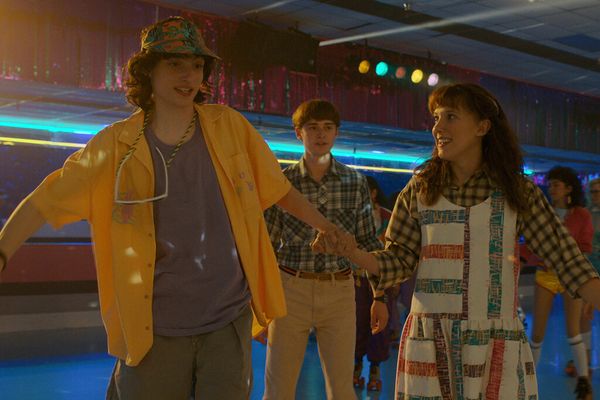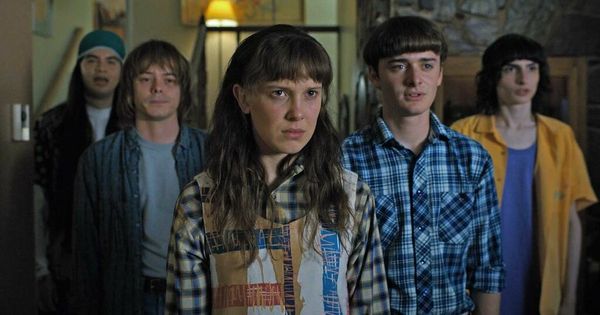
I’m sure you don’t need telling about the nostalgic appeal of Stranger Things. For a series that traffics in all manner of supernatural occurrences – telekinetic teenagers, alternate dimensions, demonic possessions – it is first and foremost a series about the 1980s. Or rather, it is a series about what we all imagine the 1980s to be. Devotees of the Netflix sci-fi have drawn the obvious comparisons to old Stephen King stories, the films of John Carpenter and Steven Spielberg. The latest season borrows heavily from 1984’s horror classic A Nightmare on Elm Street. But Stranger Things has always lacked the depth of its forebears, as well as a rounded interest in the realities of the time period. It is, as the kids say, “no thoughts, just vibes”.
The series, which returned for the first “volume” of its fourth season on Friday, is one of many recent films and TV shows to have plumbed this specific reserve of nostalgia. Without even leaving Netflix, you’ve got projects like Russian Doll, Glow and Black Mirror’s much-talked about episode “San Junipero”; elsewhere, everything from The Americans, to The Deuce to Super 8 has thrust viewers back to the Eighties. The teen protagonists of the 2017 King adaptation It seemed to breathe the very same air as the Stranger Things kids – if It weren’t already deep into development when Stranger Things first debuted, you’d swear to God that a studio executive must have just turned on Netflix one evening and gone, “I want that”.
The appeal of the 1980s should be fairly obvious. It draws on not just a nostalgia for the past, but for a lived past. Much of Stranger Things’ core viewing demographic would have grown up in the 1980s, or otherwise lived through it. Though even if you weren’t born then, you likely still grew up ensconced in the era’s afterglow – the films, the music, the fashion. (Another crucial factor in the appeal of the 1980s: it was the last decade in history before the popularisation of the internet and mobile phones.)
Of course, cinema and TV have always indulged a fascination with bygone decades. In the 1970s and 1980s, you had huge hits like Back to the Future or Happy Days which drew on the exact same sense of lived nostalgia. To its credit, Stranger Things’ approach to the 1980s mostly avoids lapsing into overt sentimentality about the glory days. As with a lot of 1980s supernatural fiction, the show actually uses its horror-inflected premise to explore the unseen evils beneath the surface of suburban American life. The problem arises when we ask why, exactly, creators Matt and Ross Duffer chose to set the show in this time period. Is there a better reason than simple convenience? A handy plot contrivance? What does it really want to say about the era?
The very best TV period dramas of recent years – Mad Men; The Deuce; Halt and Catch Fire – understand their time period not as just an aesthetic, a set of circumstances and events, but as a fluid part of the larger continuum of human history. The 1980s aren’t a “vibe” but an obscenely complex matrix of socio-economic movements, interpersonal histories and conflicting ideologies. When you watch Stranger Things, or It, the Eighties aesthetic feels simply like a fad. When you watch The Deuce – or, to use a British example, Shane Meadows’ brilliant This is England ‘86 and ‘88 – it could hardly feel more real.
I am hardly, of course, the first person to politely suggest that Stranger Things is more style than substance. Back in 2017, The Telegraph’s Robbie Collin described the series as “pandering and empty – the TV equivalent of those social media accounts that post things like ‘Retweet if you loved watching Airwolf’.” But it is a point worth reiterating, especially as we look to be on the cusp of a new wave of throwback series set during the roaring Nineties. The decade, long considered too garish and obnoxious to romanticise, has served as the window dressing for a number of recent projects, laser-targeted at aging young millennials. Among them: Yellowjackets, Netflix’s Fear Street: 1994, That ‘90s Show, Pam & Tommy and Young Sheldon. The nostalgia boom will not end with Stranger Things.
The past, as they say, is a foreign country – and who doesn’t love a holiday abroad? Stranger Things has been undeniably useful in articulating our collective yearning for a not-too-distant past, for a way of living that is already foreign to us. But after four seasons, its reductive vision of the 1980s remains little more than a backdrop.










